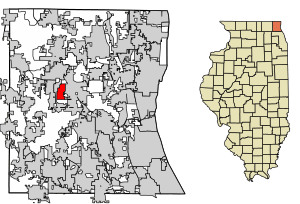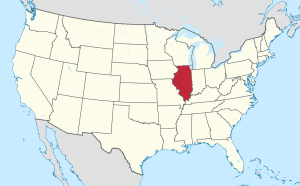Hainesville, Illinois facts for kids
Quick facts for kids
Hainesville, Illinois
|
|
|---|---|

Location of Hainesville in Lake County, Illinois.
|
|

Location of Illinois in the United States
|
|
| Country | United States |
| State | Illinois |
| County | Lake County |
| Area | |
| • Total | 1.88 sq mi (4.87 km2) |
| • Land | 1.85 sq mi (4.78 km2) |
| • Water | 0.03 sq mi (0.09 km2) |
| Population
(2020)
|
|
| • Total | 3,546 |
| • Density | 1,919.87/sq mi (741.30/km2) |
| Time zone | UTC-6 (CST) |
| • Summer (DST) | UTC-5 (CDT) |
| Zip |
60030,60073
|
| Area codes | 224, 847 |
| FIPS code | 17-32200 |
| Wikimedia Commons | Hainesville, Illinois |
Hainesville is a small village located in Avon Township, Lake County, Illinois, in the United States. In 2020, about 3,546 people lived there. Hainesville is special because it's the oldest community in Lake County to be officially recognized as a village.
Contents
History
How Hainesville Started
In 1838, a young boy named Elijah M. Haines and his family moved from New York City to the Chicago area. When he was older, in 1836, Elijah bought a farm in what would become Hainesville. He even taught school in Waukegan, Illinois for a while.
In 1846, Elijah Haines planned out the village of Hainesville. The village was officially recognized on February 26, 1847. It's said that Elijah Haines met Abraham Lincoln in 1847. They became good friends, and Lincoln might have even stayed overnight in Hainesville a few times.
Around 1848, work began on a special road called the Lake and McHenry Plank Road. By 1851, this road was finished near Hainesville. The village became home to one of three toll houses where people paid to use the road.
Elijah Haines became a lawyer in 1851. He later moved to Waukegan. In 1859, he was elected to the state government. He served there for eight terms, helping to make laws for Illinois. He was also very important in creating the Illinois Constitution in 1869-70.
The Railroad's Impact
Hainesville was growing, but then it almost disappeared from maps for a while. In 1899, the Milwaukee Road railroad came to Lake County. This made it easy to travel from the area to Chicago.
A local landowner in Hainesville asked for a lot of money to build a train station there. The railroad company decided to build their station in Round Lake instead. This was because a man named Amarias M. White offered them land for free. Because of this, businesses and people started moving away from Hainesville to Round Lake and Grayslake.
The Hainesville post office closed in 1919. A few years later, a tornado destroyed the old wooden Hainesville School. A new brick school was built in 1940. But in 1945, this school became part of the Round Lake School system. The building later became Hainesville's village hall from 1982 to 2005.
Growing Again
After many quiet years, Hainesville started to grow quickly. In the 1990s, old farmlands were turned into new neighborhoods like Misty Hill Farm and Deerpoint Trails.
In the early 2000s, more homes were built. For example, land around Cranberry Lake became a new housing area. A sports complex called Softball City was also sold and became a community of townhouses.
In 2002, a new school called Prairieview School was built for younger students. More townhouses were built near Cranberry Lake in 2003.
Because of all this growth, a special count of the population was done in 2004. It showed that Hainesville's population had grown by over 60% in just four years!
Where is Hainesville?
Hainesville is located at 42°20′56″N 88°4′7″W / 42.34889°N 88.06861°W.
According to information from 2010, Hainesville covers about 1.81 square miles (4.7 square kilometers). Most of this area is land, with a small part being water.
Important Roads
Here are some of the main roads in Hainesville:
Who Lives in Hainesville?
How the Population Changed
The number of people living in Hainesville has changed a lot over the years. Here's a look at the population from different census counts:
| Historical population | |||
|---|---|---|---|
| Census | Pop. | %± | |
| 1880 | 103 | — | |
| 1910 | 66 | — | |
| 1920 | 84 | 27.3% | |
| 1930 | 81 | −3.6% | |
| 1950 | 154 | — | |
| 1960 | 132 | −14.3% | |
| 1970 | 142 | 7.6% | |
| 1980 | 187 | 31.7% | |
| 1990 | 134 | −28.3% | |
| 2000 | 2,129 | 1,488.8% | |
| 2010 | 3,597 | 69.0% | |
| 2020 | 3,546 | −1.4% | |
| U.S. Decennial Census 2010 2020 |
|||
Different Backgrounds
The table below shows the different racial and ethnic groups living in Hainesville. The US Census counts people of Hispanic/Latino background separately, as they can be of any race.
| Race / Ethnicity (NH = Non-Hispanic) | Pop 2000 | Pop 2010 | Pop 2020 | % 2000 | % 2010 | % 2020 |
|---|---|---|---|---|---|---|
| White alone (NH) | 1,751 | 2,322 | 1,976 | 82.25% | 64.55% | 55.72% |
| Black or African American alone (NH) | 31 | 140 | 193 | 1.46% | 3.89% | 5.44% |
| Native American or Alaska Native alone (NH) | 2 | 11 | 6 | 0.09% | 0.31% | 0.17% |
| Asian alone (NH) | 116 | 417 | 364 | 5.45% | 11.59% | 10.27% |
| Pacific Islander alone (NH) | 0 | 1 | 2 | 0.00% | 0.03% | 0.06% |
| Other race alone (NH) | 1 | 9 | 18 | 0.05% | 0.25% | 0.51% |
| Mixed race or Multiracial (NH) | 30 | 91 | 129 | 1.41% | 2.53% | 3.64% |
| Hispanic or Latino (any race) | 198 | 606 | 858 | 9.30% | 16.85% | 24.20% |
| Total | 2,129 | 3,597 | 3,546 | 100.00% | 100.00% | 100.00% |
Getting Around Hainesville
Pace offers bus service on Route 570. This bus connects Hainesville to nearby places like Fox Lake and Grayslake.
See also
 In Spanish: Hainesville (Illinois) para niños
In Spanish: Hainesville (Illinois) para niños

